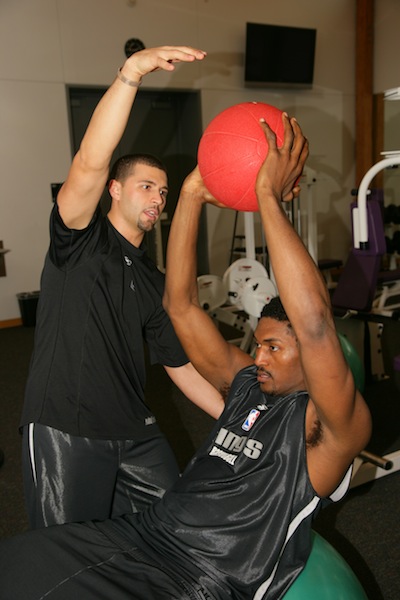By Hillel Kuttler , Special to JTNews
Leila Gray Shapiro entered the world last October 23. Because the Sacramento Kings’ NBA season was then beginning, her uncle Daniel, a coach on the team, couldn’t see little Leila for a while — so her Jewish baby-naming ceremony had to be delayed until last Sunday.
With the regular season long over and the woeful Kings again missing the playoffs, Shapiro would be back in Seattle to celebrate with his family.
Going forward, though, the Renton native’s work schedule promises to cause far less disruption. That’s because Shapiro has just left the NBA to become the strength and conditioning coach for the University of Washington Huskies men’s basketball team.
Shapiro, 35, very nearly moved home earlier this spring with the very same Kings, but the NBA blocked the franchise’s proposed sale and relocation to Seattle as the reincarnated SuperSonics.
In a telephone conversation this week, Shapiro said that “it was always a long-term goal [and] always a dream” for him to move back to Seattle, “but I didn’t know when” the opportunity would arrive.
The best he could do in recent years was to return every December 24 — the Kings usually had Christmas off — to partake in Latkepalooza, the Seattle Jewish community’s large singles event. That’s where the still-single Shapiro went to catch up with old friends; as a young man, he attended Hebrew school and Olympia’s Camp Solomon Schechter, played basketball for BBYO’s Eastside and Rainier chapters, and served as president of his United Synagogue Youth chapter.
Since taking his new job in late May, Shapiro has begun settling in. He found an apartment to rent in nearby Kirkland and plans to join the synagogue he was raised in, Herzl-Ner Tamid, on Mercer Island.
Shapiro spent eight years with the Kings. They reached the playoffs his first season there, but quickly sank to mediocrity and then irrelevance and haven’t returned to the postseason since.
Throughout his career, which began with Ohio’s University of Dayton in 2003, Shapiro said, he has not worked with another Jewish coach or player — with one notable exception. That occurred for two seasons, beginning in 2009, when forward Omri Casspi joined the Kings and became the first Israeli to reach the NBA. Casspi and Shapiro quickly became friends. They often shared meals in Sacramento and on the road, and celebrated Jewish holidays together. The two even lit Hanukkah candles in a room in the Kings’ arena following a 2009 game, joined by their mothers, who were visiting.
Casspi’s trade to the Cleveland Cavaliers two years ago curtailed their get-togethers. Shapiro and Casspi last saw one another in January, when the Kings and Cleveland played each other twice.
“I’m happy for him,” Casspi, reached Tuesday in Tel Aviv, said of Shapiro’s job with the Huskies. “He’s a class act, one of the nicest guys there was in the league — aside from his ability as a strength and conditioning coach.”
“We had some wonderful years in Sacramento,” Casspi said, likely referring to their friendship rather than the team’s play during their two seasons together that produced a 49-115 win-loss record. “The organization and players love him. He matured and grew up as a man there. Going to the University of Washington — I’m so happy for him.”
With the Kings, Shapiro helped players rehabilitate from various injuries, devised exercise and nutritional regimens to keep them in top physical shape and even helped them stretch their bodies before games. His job promises to be much the same at the UW, he said.
Huskies players so far seem impressed by Shapiro’s NBA pedigree, although the team’s head coach, Lorenzo Romar, actually played in the league. The players, Shapiro said, have asked how he enjoyed training such Kings players as Tyreke Evans and DeMarcus Cousins.
In a June 6interview, Romar said Shapiro represents “the best of both worlds” through his NBA and college experience.
“I didn’t realize until I saw him [working with Huskies players] what a good teacher he was,” Romar said. Before he’d even begun supervising their weightlifting, Shapiro explained how specific exercises would activate various muscles — and how that would relate to basketball play, Romar said.
“He speaks the guys’ language while still holding their respect,” Romar said.
The challenge of helping young players to achieve their potential remains consistent in Shapiro’s new position.
“I’m training kids who are trying to get where I’ve been. I can help them work toward the same goal,” Shapiro said.
Huskies players already have “asked me certain questions: How high did this guy jump? How strong is that guy?” Shapiro said. “I’m excited about the new challenge: To get the most out of young athletes, to be a role model to some fine young men, to be an important character for teens in their development as winning athletes.”
